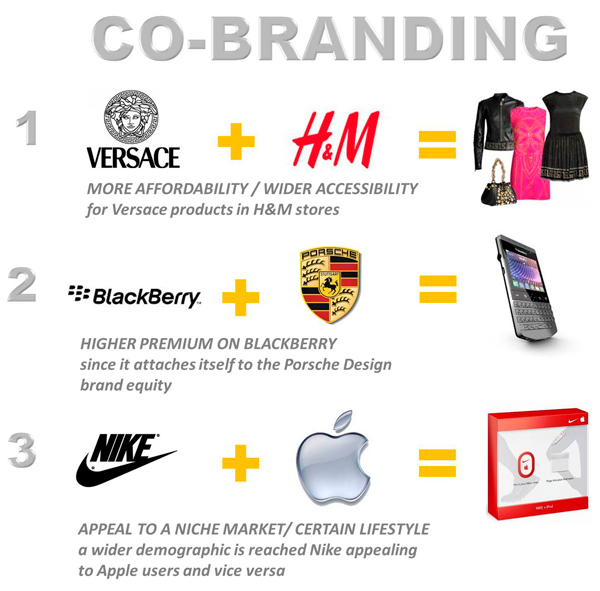Co-Branding and Ingredient Branding
Marketers often combine their products with products from other companies in various ways. In co-branding—also called dual branding or brand bundling—two or more well-known brands are combined into a joint product or marketed together in some fashion. One form of co-branding is same-company co-branding, as when General Mills advertises Trix cereal and Yoplait yogurt. Other forms are joint-venture co-branding, multiple-sponsor co-branding, and retail co-branding.For co-branding to succeed, the brands must separately have brand equity—adequate brand awareness and a sufficiently positive brand image.

The main advantage of co-branding is that a product can be convincingly positioned by virtue of the multiple brands, generating greater sales from the existing market and opening opportunities for new consumers and channels. It can also reduce the cost of product introduction because it combines two well-known images and speeds adoption. And co-branding may be a valuable means to learn about consumers and how other companies approach them.
The potential disadvantages are the risks and lack of control in becoming aligned with another brand. Consumer expectations of co-brands are likely to be high, so unsatisfactory performance could have negative repercussions for both brands. Also, consumers may feel less sure of what they know about the brand
Ingredient branding is a special case of co-branding. It creates brand equity for materials, components, or parts that are necessarily contained within other branded products. For host products whose brands are not that strong, ingredient brands can provide differentiation and important signals of quality.
An interesting take on ingredient branding is self-branded ingredients that companies advertise and even trademark.
Westin Hotels advertises its own “Heavenly Bed”—an important ingredient for a guest’s good night’s sleep.

Ingredient brands try to create enough awareness and preference so consumers will not buy a host product that doesn’t contain it.
What are the requirements for successful ingredient branding?
- Consumers must believe the ingredient matters to the performance and success of the end product. Ideally, this intrinsic value is easily seen or experienced.
- Consumers must be convinced that not all ingredient brands are the same and that the ingredient is superior.
- A distinctive symbol or logo must clearly signal that the host product contains the ingredient. Ideally, this symbol or logo functions like a “seal” and is simple and versatile, credibly communicating quality and confidence.
- A coordinated “pull” and “push” program must help consumers understand the advantages of the branded ingredient. Channel members must offer full support such as consumer advertising and promotions and—sometimes in collaboration with manufacturers—retail merchandising and promotion programs
